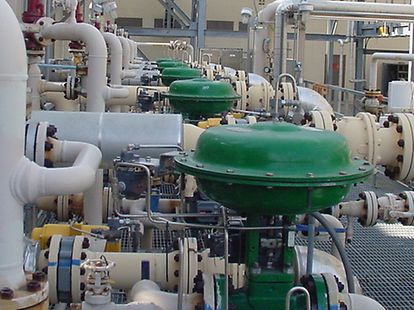Innovative Control Valves: Enhancing Precision and Integrity
Innovative Control Valves: Enhancing Precision and Integrity
Blog Article

Maximize Energy Financial Savings and Comfort With Advanced Structure Automation Controls
In the world of contemporary design and facility management, the integration of innovative building automation controls stands as a pivotal development. By taking advantage of the power of automation, structures can adapt, react, and advance in methods that were as soon as unimaginable.
Power Performance Benefits
Energy efficiency benefits can dramatically decrease energy consumption and functional costs in structures. Energy-efficient systems, such as sophisticated structure automation controls, can maximize the usage of sources like lighting, home heating, and cooling, leading to reduced power expenditures over time.
Moreover, boosted energy efficiency can prolong the life-span of building tools and systems. By operating a lot more efficiently, heating and cooling systems, light, and various other structure elements experience less deterioration, resulting in lowered upkeep and substitute prices. Additionally, energy-efficient structures typically command greater residential or commercial property worths and rental prices, offering lasting economic benefits to owners.
In addition, power effectiveness can enhance owner convenience and efficiency. Appropriately controlled interior settings with optimal lights and thermal problems produce a more helpful and pleasurable workspace, resulting in boosted employee complete satisfaction and efficiency. On the whole, the power performance benefits connected with sophisticated building automation controls are diverse, encompassing expense savings, environmental stewardship, and resident well-being.
Improved Comfort Control
Enhancing comfort control in building atmospheres calls for an innovative integration of sophisticated automation systems for ideal passenger wellness. By utilizing innovative structure automation controls, centers can customize the interior atmosphere to meet the specific demands and preferences of owners. These systems enable precise guideline of illumination, air flow, and temperature, creating a efficient and comfy ambience. Passenger contentment and efficiency are very closely connected to thermal comfort, making it vital to have systems in location that can adapt to altering conditions in real-time.
By integrating these innovative controls, buildings can not only improve comfort yet likewise improve energy effectiveness by maximizing system procedures based on actual tenancy and usage patterns. Ultimately, focusing on passenger convenience via advanced automation systems leads to a much more enjoyable and much healthier indoor atmosphere.
Operational Effectiveness Improvements

In addition, the execution of real-time monitoring and analytics devices enables structure drivers to identify power inadequacies and operational anomalies promptly. By continuously monitoring power usage patterns and system performance metrics, adjustments can be made in real-time to optimize power consumption and guarantee peak operational performance. control valves. Furthermore, incorporating need response techniques right into building automation controls can even more boost operational efficiency by dynamically changing power usage based upon grid conditions and rates signals
Indoor Climate Optimization
Effective interior environment optimization is a basic facet of structure automation controls, guaranteeing owners' convenience and well-being while taking full advantage of energy cost read what he said savings. By utilizing sophisticated sensing units and controls, developing automation systems can constantly adjust and monitor temperature, humidity levels, air high quality, and ventilation to create an optimal indoor setting. Keeping consistent and comfortable conditions not just boosts resident contentment but additionally boosts productivity and overall health.
Interior climate optimization also plays a critical function in power effectiveness. By fine-tuning cooling, home heating, and air flow systems based upon real-time information and occupancy patterns, constructing automation controls can substantially minimize power usage - control valves. For circumstances, implementing strategies such as demand-controlled ventilation and thermal zoning can assist decrease power waste while guaranteeing that each area of the structure obtains the needed conditioning.

Lasting Environment Production
Structure automation controls not only enhance interior climate problems for power efficiency and passenger convenience but likewise lay the structure for producing a sustainable setting via tactical management of systems and resources. By integrating advanced structure automation innovations, such as sensing units, actuators, and smart software, facilities can readjust and monitor power usage in real-time to lessen waste and minimize their carbon impact. These systems make it possible for predictive maintenance, recognizing potential concerns before they escalate and optimizing tools performance to improve durability and efficiency.
Additionally, lasting environment creation prolongs past energy management to incorporate water conservation, waste decrease, and indoor air top quality enhancement. Structure automation controls can regulate water usage, detect leaks, and guarantee proper waste disposal techniques, adding to overall sustainability initiatives. Additionally, by keeping an eye on and managing air flow and filtering systems, these technologies boost resident wellness and performance while lowering power intake connected with cooling and heating procedures.
Verdict
To conclude, progressed structure automation controls deal substantial advantages in terms of power savings, comfort control, operational effectiveness, indoor environment optimization, and creating a sustainable setting. By applying these controls, pop over to these guys buildings can accomplish optimal performance while minimizing energy intake and improving resident comfort. It is apparent that using advanced automation innovation is essential in enhancing building performance and creating an extra lasting future.
Power efficiency benefits can significantly lower energy intake and functional prices in structures. Generally, the power performance advantages connected with innovative building automation controls are complex, incorporating cost savings, ecological stewardship, and passenger well-being.
In addition, incorporating demand feedback approaches right into structure automation controls can additionally improve operational efficiency by dynamically adjusting power usage based on grid problems and prices signals.
Structure automation regulates not only optimize indoor environment conditions for energy efficiency and owner convenience however also lay the foundation for creating a lasting atmosphere with calculated administration of sources and systems.In conclusion, advanced structure automation manages offer substantial benefits in terms of energy savings, comfort control, functional effectiveness, website here indoor climate optimization, and producing a lasting setting.
Report this page